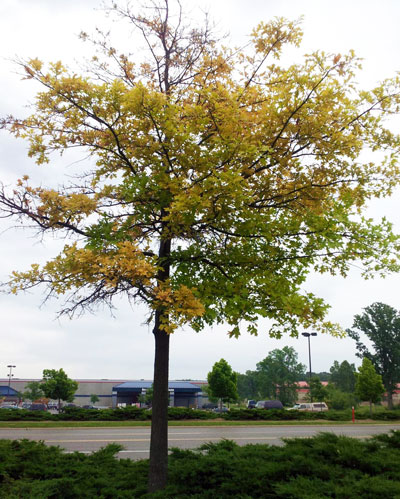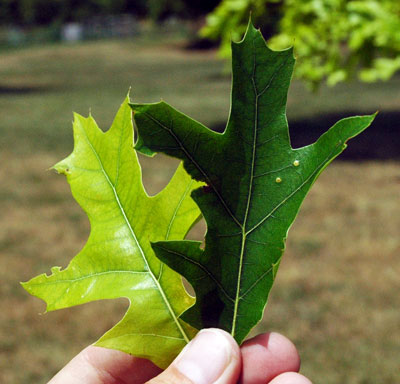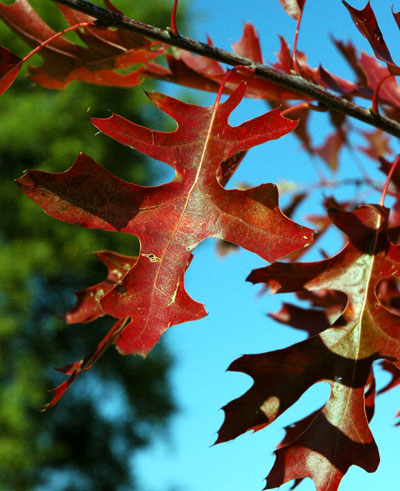Severe chlorosis in pin oaks
Yellowing in pin oaks is usually related to underlying soil issues.
Leaf chlorosis (yellowing) is a perennial problem of pin oak (Quercus palustris) trees in landscapes in many parts of Michigan. Depending on the severity of the problem, trees typically range from bright green to bright yellow. The extent of chlorosis can vary from tree to tree and even within the tree itself, with some branches appearing normal while others are severely affected. If chlorosis is severe and not treated, trees will defoliate, weaken and may eventually die. This spring, many pin oaks in the mid-Michigan area are showing especially severe chlorosis and, in some cases, the color of the leaves range from yellow to slightly orange (Photo 1).

Photo 1. Chlorosis in pin oaks may become severe enough
to cause defoliation and, ultimately, tree death.
Photo credit: Angie Tenney, MSU Diagnostic Services
Underlying cause
Chlorosis in pin oaks is usually due to a deficiency of iron in the leaves. Iron is important for chlorophyll synthesis in plants, so when it is deficient, leaves cannot make chlorophyll, resulting in a yellow appearance. Chlorosis of pin oaks is typically associated with alkaline soil pH – pH greater than 7. As soil pH increases, the ability of pin oaks to take up iron decreases dramatically.
What can be done?
The best solution for iron chlorosis is to avoid planting pin oak in alkaline soils. Some closely related species, like northern pin (Q. ellipsoidalis, Photos 2 and 3) and scarlet oak (Q. coccinea), have excellent fall color and usually hold up better to alkaline soils than Q. palustris.

Photo 2. Northern pin oak (right) shows much less chlorosis
than pin oak (left) when grown on the same site with
alkaline soil. Photo credit: Bert Cregg, MSU

Photo 3. Fall color of northern pin oak. Photo credit: Bert Cregg, MSU
It is also possible to effectively treat trees for iron chlorosis. According to Michigan State University Extension, there are four principle treatments for chlorotic pin oaks:
- Soil application of iron sulfate or sulfur
- Soil application of chelated iron
- Foliar sprays
- Trunk injection
Each treatment can be effective, but each also has limitations.
Soil application iron sulfate aor sulfur. The objective of these applications is to lower the soil pH and increase iron availability. It is important to remember that the underlying problem is usually not the amount of iron in the soil, but the amount that is available to the plant. Therefore, the advantage of this approach is by lowering soil pH, it addresses the basic problem.
There are several limitations, however. The pH-lowering effect of sulfur-containing compound can be slow. Also, soil pH will tend to creep back up, so treatments need to be re-applied every few years.
Soil application of chelated iron. The objective of this approach is to apply iron in a form that is readily taken up by trees. Application of iron chelates can produce greening within a couple weeks. The disadvantage is the effect can be short-lived and can be relatively expensive.
Foliar application of iron. Iron sulfate or iron chelates can be applied to trees as a foliar spray. This can often provide a rapid green-up within days or a week. Some leaf burn is also possible, however. The treatment does not address the underlying cause and the effect may only persist for a year.
Trunk injection of iron. Professional arborist can apply iron to trees via trunk injection. This enables treatment of trees that are too large to effectively apply a foliar spray. Trunk injection can also provide a rapid green-up often within a week. Again, the treatment does not address the basic problem of alkaline soils and usually needs to be re-applied every couple years.
For more details on treating tree for iron chlorosis, see “Preventing and Treating Iron chlorosis in Trees and Shrubs” from Utah State University Cooperative Extension.



 Print
Print Email
Email




